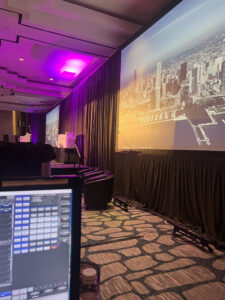If your stage sound system is not set up properly, you may end up with many issues during the show. Regardless of your level of experience, knowing how to set up a stage sound system enables you to deliver crisp, effective, and dependable sound to everyone. For high-stakes events, many turn to professional audio companies in Atlanta, GA, to ensure flawless execution and expert-level support.
This step-by-step guide from HuView Production breaks it down, so your audience hears every word and note, wherever they are. Huview Productions is an AV production company in Atlanta with the technical expertise to ensure your sound system is professionally configured for any event.
Pre-Setup Considerations For Sound System
- Check what you will need for the event before you make any connections.
- Do the events take place inside buildings or in outside areas? Every instrument is built to make a certain kind of sound.
- The number of people attending an event affects the strength and number of participants.
- How big the stage is and how it is arranged can guide where you put your mics and monitors.
- Confirm that the area has stable and sufficient electricity available.
- Sound reflection: Observe surfaces that might echo or bounce the sound.
Sound System Setup for Different Outdoor and Indoor Events and Venues
Business Presentations and Conferences
- Use lapel (lav) or headset mics for presenters so they can move freely and be heard clearly.
- Add podium mics for formal speeches.
- Use a mixer with multiple channels to handle different mic sources.
- Place compact speakers around the room to avoid volume drop-offs.
- Use feedback control tools to stop mic squeals in large halls.
Tip: Delay speakers placed further from the stage to keep audio in sync.
Music Festivals and Concerts
- Use line array speakers to cover wide areas and large crowds.
- Add multiple subwoofers to handle bass-heavy music.
- Wireless mics and in-ear monitors keep the stage clear and performers mobile.
- Bring a digital mixer with preset scenes to switch between bands quickly.
- Use monitor speakers or in-ear systems for each band member.
Tip: Always test gear outdoors; wind and space can affect how sound travels.
Weddings and Private Events
- A portable PA system is often enough for speeches and music.
- Use wireless handheld mics for toasts and announcements.
- A DJ mixer is helpful if there’s a dance floor or live entertainment.
- Place small powered speakers around the room for even sound without being too loud.
Tip: Keep the mic range short to avoid signal dropouts during speeches.
Outdoor Events and Open Spaces
- Use weather-resistant speakers and covers in case of rain or moisture.
- Bring power generators if the location has no reliable electricity.
- Choose speakers with long-throw capability to reach people far from the stage.
- Place speakers high off the ground to spread sound evenly.
Tip: Test for wind noise and have foam windscreens for all mics.
Trade Shows and Product Launches
- Use compact powered speakers that are easy to move and set up.
- Add wireless clip-on mics for hands-free presentations.
- Use mixer/audio interfaces for music playback and live demos.
- Add video-audio sync gear if there’s a visual display or screen.
Tip: Keep the sound focused to avoid distracting nearby booths.
Step-by-Step Guide to Set Up a Stage Sound System
1. Plan the Stage Layout
- Decide where the performers, microphones, speakers, and monitors will go.
- Place the main speakers facing the audience.
- Place the angle monitors towards the performers.
- Mark cable paths with tape to prevent tripping.
2. Set Up the Mixer
- Place the mixer where the sound crew can hear the full mix (usually front of house).
- Label each input channel before connecting anything.
- Connect microphones, instruments, and playback devices to the mixer.
3. Connect Amplifiers and Speakers
- Match amplifier power to the speaker ratings.
- Use SpeakON or 1/4″ TRS cables for speaker connections.
- Keep cables away from walkways.
- Position speakers for even sound coverage.
4. Position and Connect Microphones
- Place vocal mics close to the performer’s mouth.
- Aim the instrument mics at the sound source (like guitar amps or drum kits).
- Use XLR cables to connect mics to the mixer.
- Secure cables to avoid movement or damage.
5. Set Up Stage Monitors
- Choose floor monitors or in-ear systems based on the event.
- Set up a separate monitor mix from the main mix.
- Use EQ to cut feedback frequencies.
- Make sure performers can hear themselves.
6. Perform a Sound Check
- Start with each channel’s gain, then adjust volume with faders.
- Test all mics and instruments one by one.
- Walk the venue and listen for volume issues or dead spots.
- Ask performers for feedback and adjust monitors if needed.
Common Mistakes to Avoid while Setting Up a Stage Sound System
Skipping the Sound Check
Not testing your sound systems before the event is one of the biggest mistakes. Without checking the sound, you won’t be able to know if the levels are too loud, too soft, or if something isn’t working.
Fix: Always do a full sound check with all mics, monitors, and speakers before people arrive.
Using the Wrong Cables or Connectors
Plugging the wrong cable into the wrong input can damage equipment or stop it from working.
Fix: Always match cables to their correct ports (like XLR to mic input, SpeakON to speakers). Don’t force anything that doesn’t fit.
Poor Speaker Placement
Putting speakers in the wrong spot can create feedback, uneven volume, or unclear sound for the audience.
Fix: Aim speakers at the audience. Keep monitors pointed at the performers. Avoid pointing speakers at mics.
Not Labeling Mixer Channels
If mixer channels aren’t labeled, you won’t know what you’re adjusting during the event.
Fix: Use tape or a marker to label each mixer channel clearly—vocals, instruments, monitors, etc.
Overloading Power Circuits
Plugging too many devices into the same outlet can cause outages or blow breakers mid-show.
Fix: Spread out your power load. Use separate circuits when possible and test them ahead of time.
No Backup Gear
If there’s no backup gear or equipment, the event can be ruined. The cable can fail, and the mic may die in between the events, so you must be ready with the backup equipment.
Fix: Always bring spare mics, cables, batteries, and adapters, and make them ready to use.
Ignoring Room Acoustics
Every venue sounds different. Sound bounces off hard surfaces, while sound gets absorbed when there’s carpet in the venue. Ignoring this can lead to a sound that feels off.
Fix: Walk the space during setup. Adjust speaker angles or volume to match the room’s shape and materials.
Key Tips for Setting Up a Stage Sound System Smoothly
Carry spare gear: Bring extra cables, microphones, batteries, and power strips. If something stops working, you’ll be ready.
Pack a basic tool kit: Pack a set of tool kit like tape, adapters, screwdrivers, zip ties, and a multimeter to test connections. You can fix small issues with a basic tool kit quickly without stopping the show.
Label everything: Use tape or stickers to label all cables, channels on the mixer, and gear bags to save time and avoid confusion during the sound system setup.
Keep your area safe: Tape down loose cables and keep gear off walkways. This prevents trips and accidents, especially in dark or crowded spaces.
Run a final check: Test the full system before the event starts. Play sound through each speaker, test each mic, and confirm everything is working as expected.
Know local rules: Some cities have volume limits or electrical rules. Learn them before you arrive so you don’t face surprises during the event.
Conclusion
Setting up a stage sound system takes planning, the right gear, and clear steps. From choosing your equipment to testing everything before showtime, each part of the process matters. A reliable setup means better sound, smoother events, and fewer problems on the day.
Follow the steps in this guide, avoid common mistakes, and use the tips provided to stay prepared. If you want expert support for your next event, HuView Productions can help you handle the sound system from start to finish, so you can focus on delivering a great experience.







